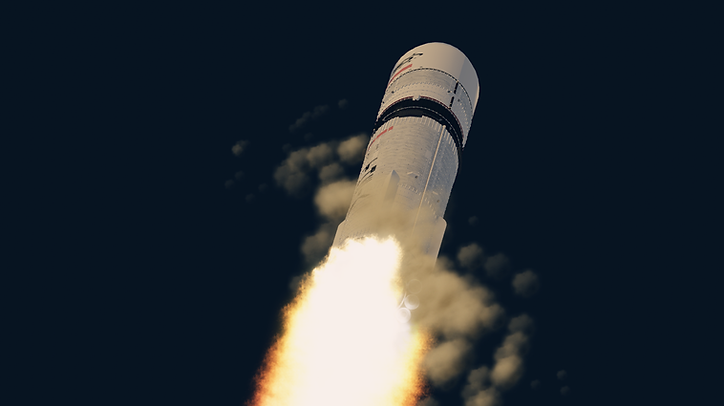01/01/2023
BREAKING NEWS
GTRAD RETURNS TO THE INDUSTRY ACHERON FIRES ITS SEVEN ENGINES FOR THE FIRST TIME WILL OSIRIS EVER FLY AGAIN? MONTHS OF HARDWARE AND MANAGEMENT CHANGES MAKE THE VEHICLE'S FUTURE UNCERTAIN WHAT HAPPENED TO KARMAN AEROSPACE? TOTAL SILENCE FROM THE COMPANY CONFUSES THE INDUSTRY
Theia Launches on Exciting Debut Flight, Falls Short of Orbit
GSST’s new heavy lift rocket launches from Florida with experimental payload, suffers multiple anomalies but completes critical first steps toward reusability.
27 July, 2025
John Doe
This article is classed as
ACCURACY REALISM

Theia during ascent as multiple engines shutdown. Image: Kwingo_NL
GSST’s new flagship vehicle, Theia, took to the skies for the first time on Saturday night, thundering off Launch Complex 2 at 10:48 PM EDT. Designed as a more powerful and polished successor to the Rhea vehicle. Though the rocket did not reach orbit and suffered multiple in flight anomalies, the mission provided critical data as GSST continues to push forward with one of the most ambitious rocket development programs in RoSpace.
Lifting off from the southern edge of Rodriguez Key, Theia carried with it multiple GalacticNet experimental satellite payloads, the first in a series of planned low Earth orbit demonstrators.
From the very start, the mission had its issues. At T 0, the vehicle hesitated for 39 seconds on the pad in what GSST related to script lag. When the rocket finally came off the pad, the liftoff was far more energetic than anticipated, putting Theia into a steep ascent that would affect the flight plan in the minutes to follow.
The 85.3 meter tall rocket is powered by 25 BS-4B engines on its reusable first stage, delivering over 14,700 kilonewtons of thrust at liftoff. During the climb, a total of six engines either flamed out or failed to ignite altogether, a rate not entirely unexpected but one that added to ascent challenges.
Separation between stages occurred at T+3 minutes and 8 seconds, with the booster initiating its experimental partial boostback maneuver 11 seconds later using eight of its nine inner ring engines.
Two additional engine failed during the burn, and after shutdown, the vehicle began a controlled reorientation using gridfins. Unfortunately, it lost attitude control during atmospheric entry, tumbled, and eventually broke up. GSST reports the breakup remained inside hazard zones.
The second stage, equipped with a pair of GTRAD’s new BS-2C vacuum engines, performed well following ignition at T+3:17. Fairing deployment occurred smoothly, but by T+8:50, electrical problems affecting attitude control caused telemetry to show one out of the two engines were running.
Although both engines appeared to be firing, the loss of guidance capability resulted in inefficient course adjustments. The vehicle shut down prematurely and did not reach its target orbital velocity, later breaking up during an uncontrolled descent.
"It deadass got off the pad?!" Said Xavierevator, CEO of GSST.
Theia liftoff and ascent, showcasing the full duration of the pad stay. Video: Kwingo_NL
“Not a bad flight,” said Allan, management lead at GSST. “We got good data out of it for Theia Block 1.5 to improve a lot on. I would like to congratulate the GSST team for what we accomplished today, and we have to do a little clean up on LC-2 since the engines blasted the ground for a bit.”
The company confirmed that the next iteration of Theia, the Block 1.5, will incorporate structural and software upgrades in direct response to this flight’s findings.
While the booster’s loss was a disappointment, the recovery attempt tested and demonstrated important system behavior in live conditions for the first time, providing the teams with useful data to improve on for the next line of boosters.
“There’ll be a bit of downtime as we evaluate what we need to improve on,” Allan added, “but hopefully the next launch of Theia will happen in 4–8 weeks. Rhea launches will resume soon as we prepare and plan the next 3 flights.”
Even with multiple engine failures, avionics issues, and incomplete orbital insertion, the debut flight provided real world validation for systems still under development. For the GalacticNet payload, the mission was primarily a technology demonstration, and failure was anticipated as a possible outcome.
GTRAD, the engine supplier for GSST, will use data from this flight to improve on their engine systems to improve reliability for future launches. "GTRAD is ruined" said Chris_HadfieldCA, founder and CEO of the company.
"It was definitely an interesting launch, I enjoyed commentating. Not full success but definitely not unexpected. Success comes from what we learn, and we learned a lot." Said Kwingo, part of the media team for GSST.
While the final result may have fallen short of orbit, Theia’s debut flight succeeded in clearing the launchpad and demonstrating major flight systems, which is no small feat for a brand new vehicle.
With improvements already in development, Theia Block 1.5 is expected to return to the pad later this year with better performance, higher reliability, and more confidence in future flights.
The debut flight proved itself to be a difficult but bold step forward.





